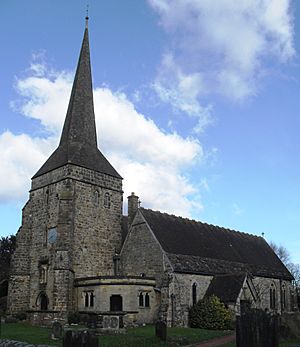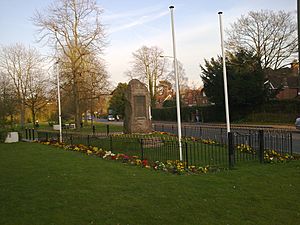Battle of Muster Green facts for kids
Quick facts for kids Battle of Muster Green |
|||||||
|---|---|---|---|---|---|---|---|
| Part of the First English Civil War | |||||||
 Muster Green (the site of the battle) in 2007 |
|||||||
|
|||||||
| Belligerents | |||||||
| Commanders and leaders | |||||||
| Edward Ford Earl of Thanet |
Herbert Morley | ||||||
| Strength | |||||||
| ~ 1,000 foot 100 dragoons |
~ 250 foot and horse | ||||||
| Casualties and losses | |||||||
| 200 killed, wounded, or captured | Unknown | ||||||
The Battle of Muster Green (also called the Battle of Haywards Heath) was a small but very important battle. It happened in early December 1642 during the First English Civil War. The fight took place on and around Muster Green in Haywards Heath.
A Royalist army, led by Colonel Edward Ford, was marching to take the town of Lewes for King Charles I. They met a smaller, but well-trained, Parliamentarian army. This Parliamentarian force was led by Colonel Herbert Morley and was waiting on Muster Green.
Royalist soldiers fired their muskets first. But Morley's cavalry (horse soldiers) broke through the Royalist front lines. At the same time, the Parliamentarian foot soldiers charged forward. They fought hand-to-hand for at least an hour. About 200 Royalists were killed, wounded, or captured. The remaining Royalist forces ran away, and the Parliamentarians won. This victory saved Lewes from being attacked by the Royalists. It also stopped Ford's Royalist advance into Sussex. The battle site at Muster Green was the furthest any large Royalist army ever got into Sussex during the English Civil Wars.
Why the Battle Happened
Sides in the English Civil War
At the start of the First English Civil War, it wasn't clear who would support the King (Royalists) or Parliament (Parliamentarians) in Sussex. Some historians thought the eastern part of Sussex was mostly for Parliament. They believed the western parts were more for the King.
But this wasn't always true everywhere. For example, in Chichester, rich families and church leaders supported King Charles I. But the growing merchant class (business people) supported Parliament. Most poor people didn't really want to pick a side.
Sussex's Importance in the War
It soon became clear that neither side could control Sussex without fighting. Sussex was important for two main reasons. First, it had many cannon factories and ironworks in the High Weald area. Controlling these would give a big advantage to whichever side had them.
Second, the Sussex coastline was a short route to France. France could be a source of weapons, gunpowder, soldiers, and money. It also offered an escape route for the King. Because of these reasons, Parliament needed to keep Sussex under strong control.
Royalist Plans for Sussex
In August 1642, King Charles I started the First English Civil War. He had control of northern England, most of the Midlands, and the southwest. Colonel Edward Ford was a Royalist leader. King Charles made him the High Sheriff of Sussex.
Ford promised the King "a thousand men" to conquer Sussex. On November 18, 1642, Ford marched his Royalist army into Sussex. He took control of Chichester for the King. After that, Ford planned to capture Lewes.
Getting Ready for Battle
Ford's March to Lewes
Colonel Ford decided to lead his army east through Sussex to take Lewes. He didn't go straight along the coast. Instead, he marched northeast, planning to attack Lewes from the north. We don't know exactly why he chose this route.
Perhaps Ford wanted to take longer to reach Lewes. This would give him time to force more local people to join his army. He could use threats to make them fight. This would make his army bigger, even if the new recruits weren't well-trained. This path led Ford and his army to Cuckfield. They set up camp there, about 11 miles northwest of Lewes.
Arrival at Haywards Heath
In the first week of December, Ford left Cuckfield and marched east. They likely followed the route that is now Broad Street and the B2272. This path led them towards Haywards Heath.
Haywards Heath was very different in 1642 than it is today. It was mostly open fields and small woods, with only a few houses. The town grew much later, after a railway arrived in 1841. When Ford's army reached the western edge of Haywards Heath, they found an army waiting. It was a smaller, but well-trained, Parliamentarian force. Colonel Herbert Morley led them, and they were ready on Muster Green.
The Battle Begins
Armies and Weapons
We don't know the exact size of the Royalist army. But Ford had promised the King "a thousand men." So, his army at Muster Green might have had around 1,000 soldiers. The Parliamentarian army was much smaller. They were outnumbered by at least four to one. This means Morley's force probably had about 250 men.
Even though they had fewer soldiers, Morley's men were very disciplined. This made them a more effective fighting force than Ford's army. Historians believe neither side had any large cannons (artillery) in this battle. A report from the Parliamentarian side describes the start of the battle:
The fight began with their muskets. After some shots, our horse soldiers broke into their front lines. Our footmen charged bravely into their positions at the same moment.
Fierce Fighting and Royalist Retreat
The Parliamentarians fought with "great fierceness." They engaged in bloody hand-to-hand combat. This caused many casualties for the less disciplined Royalists. Morley then sent in his extra soldiers (reserves) to finish the job. This caused Ford's army to completely run away.
The fighting lasted for about an hour. At least 200 Royalists were killed, wounded, or captured. We don't know how many Parliamentarian soldiers were hurt. The local people Ford had forced to join his army were the first to break. They threw down their weapons and ran into the countryside.
Ford and Thanet quickly fled with their cavalry back to Chichester. They left their remaining foot soldiers to fend for themselves. The battle ended with the Royalists defeated and scattered. The Parliamentarians had won a clear victory. They had saved Lewes from being attacked by the King's forces.
What Happened Next
After the Battle

After the battle, the Royalists were defeated and driven away. Muster Green remained the furthest a Royalist army ever advanced into Sussex during the First English Civil War. The local people who had been forced to fight ran south. They went to villages like Ditchling and Hurstpierpoint.
Colonel Ford "got away and left his men to take care of themselves." Ford, along with Thanet and their cavalry, quickly rode to the nearby South Downs. They went to Wiston House, which belonged to the Earl. From there, they went back to Chichester, which they had captured earlier. Later that December, Parliamentarian forces, led by Sir William Waller, surrounded Chichester. Ford and his men were taken prisoner when the Royalists surrendered on December 27, 1642. News of the Parliamentarian victory reached London on December 8.
Historian Philip Pavey believes that some Royalist soldiers ran northeast after the battle. They were chased by Parliamentarians. These Royalists may have ended up 6 miles northeast of Muster Green in West Hoathly. Pavey suggests they ran into St Margaret's Church for safety.
He says they slammed the church door shut. Then, Parliamentarian soldiers fired their muskets at the door. You can still see half a dozen small, round marks on the outside of the door today. They are about the size of small candies. These marks are the basis for this idea. We don't know what happened to these Royalists if they were inside the church. But the marks on the door suggest the Parliamentarians were not friendly.
Muster Green Today

The area around the battle site has changed a lot since 1642. In 1638, Muster Green was surrounded by fields. There were very few buildings. But when the London & Brighton Railway arrived in 1841, Haywards Heath grew very quickly. New buildings slowly started to surround Muster Green.
Today, Muster Green is completely surrounded by the town. However, its shape hasn't changed. It was always a green space between two roads. Today, Muster Green is a well-kept village green. It has won the Green Flag Award many times for being a "very best" green space. The Haywards Heath war memorial is also located on the western edge of the green.
On the eastern side of the green, there is a special plaque on a stand. It tells the story of the Battle of Muster Green. This plaque was put there in June 2015. It was suggested by historian Philip Pavey. The plaque calls the battle the Battle of Haywards Heath.

